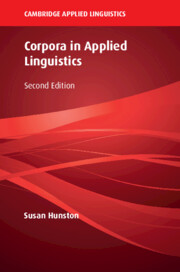Book contents
- Corpora in Applied Linguistics
- The Cambridge Applied Linguistics Series
- Corpora In Applied Linguistics
- Copyright page
- Dedication
- Contents
- Figures
- Tables
- Acknowledgements
- 1 Introduction
- 2 Designing a Corpus
- 3 Learning from a Corpus
- 4 Foundational Quantitative Concepts in Corpus Linguistics
- 5 Exploring Corpora through Quantitative Measures
- 6 The Language Learner and the Corpus
- 7 Corpora and the Analysis of Discourse
- 8 Further Applications of Corpus Research
- 9 Corpora and Language Theory
- 10 Conclusion
- References
- Index
2 - Designing a Corpus
Published online by Cambridge University Press: 21 April 2022
- Corpora in Applied Linguistics
- The Cambridge Applied Linguistics Series
- Corpora In Applied Linguistics
- Copyright page
- Dedication
- Contents
- Figures
- Tables
- Acknowledgements
- 1 Introduction
- 2 Designing a Corpus
- 3 Learning from a Corpus
- 4 Foundational Quantitative Concepts in Corpus Linguistics
- 5 Exploring Corpora through Quantitative Measures
- 6 The Language Learner and the Corpus
- 7 Corpora and the Analysis of Discourse
- 8 Further Applications of Corpus Research
- 9 Corpora and Language Theory
- 10 Conclusion
- References
- Index
Summary
This chapter is about the design of corpora and types of corpora. Changes in the concept of a corpus are discussed, in particular the provision of metadata to allow personalised sub-corpora to be compiled on an ad hoc basis from a large corpus. The design features of size, balance, representativeness and comparability are discussed, with an emphasis on the constraints imposed by practical concerns. These types of corpora are explained: general or reference, specialised corpus, diachronic, monitor, learner, pedagogic, multilingual (parallel and comparable) and multimodal. Specific issues involved in compiling corpora from particular sources are discussed. The chapter includes a list of corpora that are referred to frequently in the rest of the book.
- Type
- Chapter
- Information
- Corpora in Applied Linguistics , pp. 18 - 46Publisher: Cambridge University PressPrint publication year: 2022

